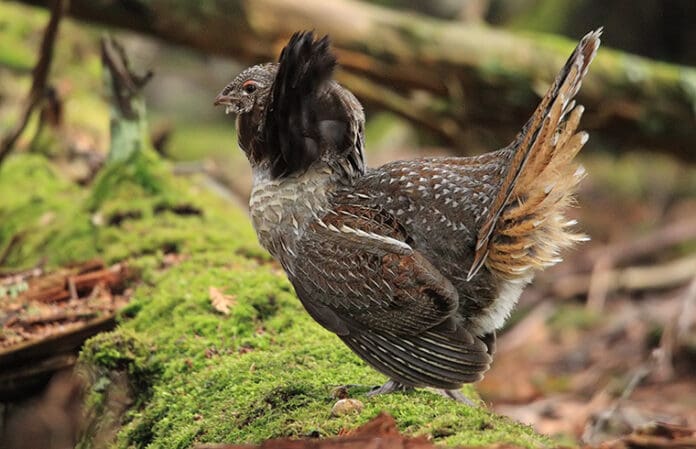DNR releases survey reports for ruffed grouse and sharp-tailed grouse
The Minnesota Department of Natural Resources’ latest ruffed grouse counts found Minnesota’s spring 2025 population is lower statewide than last year. Ruffed grouse drums per stop were 1.8 statewide, down from 2.3 drums per stop last year, an expected drop considering spring 2024 was the highest 10-year cycle population peak for ruffed grouse since 1972.
The DNR and its partners have conducted spring drumming count surveys for 74 years to monitor the state’s ruffed grouse breeding population. Through decades of surveys, DNR researchers have found that ruffed grouse populations tend to rise and fall in about a 10-year cycle that typically ranges from 8-11 years.
Warm temperatures and dry conditions have favored high nest success and chick survival the last few years and may partly explain the quicker-than-expected rise to peak levels in the current 10-year cycle last year.
Snow conditions also were favorable for roosting throughout much of Minnesota’s core grouse range during the winters of 2021-2022 and 2022-2023, followed by an unusually warm winter during 2023- 2024.
Overall, Minnesota’s climate is getting warmer and wetter with more heavy, intense rainfalls. Record high rainfall occurred in June 2024, and much of ruffed grouse range received less snowfall than normal during winter 2024-2025, likely contributing to lower ruffed grouse numbers in spring 2025 compared to 2024.
“Drumming counts alone are not an accurate way to predict the birds that will be present during the fall hunting season,” said Charlotte Roy, DNR grouse project leader. “Nesting success and chick survival during the spring and summer are contributing factors that influence the number of birds present in the fall. These factors can be reduced by heavy rain during June when nests hatch and chicks are young.”
Ruffed grouse populations are surveyed by counting the number of male ruffed grouse drums on established routes throughout the state’s forested regions.
Drumming is a low sound produced by males as they beat their wings rapidly and in increased frequency to signal the location of their territory. Drumming displays also attract females ready to begin nesting.
“In a typical year, we have 13 cooperating organizations helping us count grouse drumming,” Roy said. “We are grateful to our federal, Tribal and other partners for their assistance in completing routes.”
The 2025 ruffed grouse survey report can be found on DNR’s grouse management webpage (mndnr.gov/wildlife/grouse.html).
Sharp-tailed grouse population down in the northwest, low in east-central region
Minnesota’s northwest sharp-tailed grouse population is lower in 2025 than last year. The average number of sharp-tailed grouse per lek in the northwest was 12 this year, compared to 15.3 last year. In 2024, the northwest sharp-tailed grouse population was the highest it’s been since 2009, according to spring population counts conducted by the Minnesota DNR and cooperating organizations.
The sharp-tailed grouse population level remains low in east-central Minnesota, and the DNR has kept the hunting season closed in the east-central zone since 2021. Low population levels in this area are thought to be driven largely by changing habitat conditions. The birds require 1-3 square miles of grassland and brushland. Establishing and maintaining suitable habitats of this size often requires cooperation between multiple landowners.
The Minnesota Sharp-tailed Grouse Society, Pheasants Forever and others have collaborated with the DNR on targeted habitat management — specifically on prescribed burns, mowing and tree shearing projects — for sharp-tailed grouse and remain committed to enhancing open-land habitats to the extent possible.
The 2025 sharp-tailed grouse survey report can be found on the DNR’s grouse management webpage (mndnr.gov/wildlife/grouse.html).



